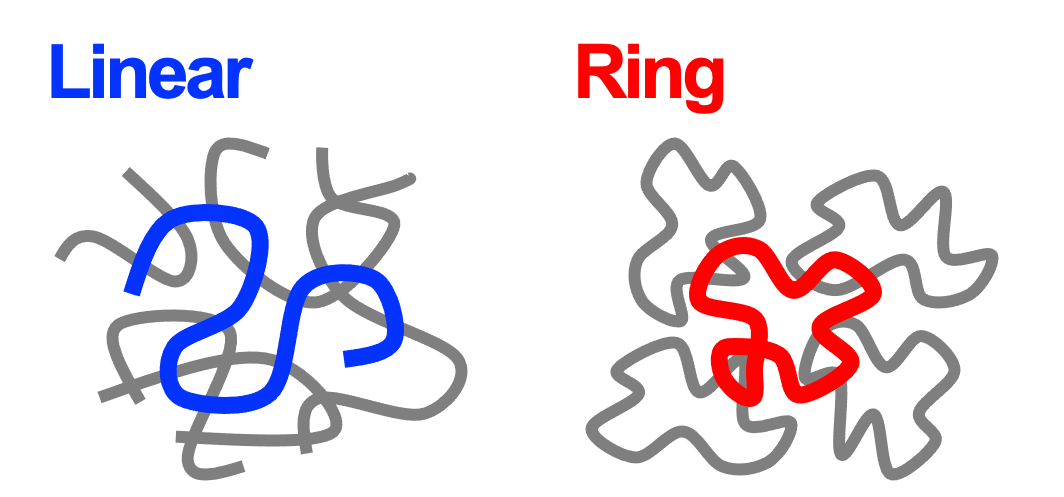研究内容 / Research
私たちの研究室では、「特殊構造高分子の合成から物性まで」を研究対象とし、高分子のナノスケールのかたちと諸性質の関係性の理解を目指して、合成・精製・物性の観点から、幅広く研究を進めています。高分子は通常モノマーが1次元状に繋がれた鎖状分子であるのに対し、環状やかご型、ナノ微粒子状やシート状といった分子鎖の繋がり方に特徴を持つモデル高分子試料の調製と分子特性(ナノスケールのかたちや動き)の解明に興味があります。これらの制御・理解が、マクロスケールの高分子材料の重要な設計指針にも繋がります。
In our laboratory, we aim to understand the relationship between the molecular architecture (i.e., chain connecting manner) and various properties of polymers at the nanoscale. To achieve this goal, we are extensively working from the aspects of synthesis, purification, characterization and physical properties of polymers. Specifically, we are interested in some model polymers with unique architectures such as ring polymers and sheet-shaped polymers. The control and understanding of these architecture and properties of these polymers at the nano-scale are an important guideline for macro-scale polymer material design.

- 環状高分子の物性解明 / Elucidation of Physical Properties of Ring Polymers
- シート状高分子の高効率合成 / Highly Efficient Synthesis of Sheet-Shaped Polymers
1. 環状高分子の物性解明 / Elucidation of Physical Properties of Ring Polymers

線状鎖の両端を繋いで得られる環状高分子は、「末端を持たない」という線状物との構造上の僅かな違いにより物性上の大きな違いを生み出すことが知られます。私たちはこれまでに独自の合成・精製技術を駆使して、線状鎖不純物を含まない高純度な環状高分子試料を調製し、その特徴的な分子特性を解明してきました。具体的には高純度環状鎖がバルク中で、(i) 線状鎖より著しく収縮した分子形態を取り、実効的分子間斥力が生じること[1]、(ii) 線状鎖に特有のゴム状平坦域/分子間絡み合いを示さず、線状鎖とは分子運動性が大きく異なること[2]、(iii) 線状鎖を添加した場合に、環状鎖への自発的な分子間貫入が生じ、環状鎖の形態や運動性が大きく変化すること[3]などです。環状/線状高分子ブレンドの更なる調査や濃厚溶液系への展開が、今後の更なる課題と考えます。
Ring polymers obtained by connecting the two ends of a linear chain are known to produce significant differences in physical properties due to the slight difference in molecular architecture from the linear ones. We have prepared highly-purified ring polymer samples free from linear chain contaminants using our unique synthesis and purification techniques, and have elucidated their characteristic molecular properties. Specifically, highly-purified ring polymers in bulk exhibit (i) a conformation that is significantly more shrunken than the linear ones, resulting in effective intermolecular repulsion [1], (ii) no rubbery plateau regions / no intermolecular entanglements seen in linear ones, and hence evidently different molecular dynamics from linear ones [2], and (iii) the addition of linear chains causes spontaneous intermolecular penetration into the rings, resulting in significant changes in the conformational and dynamics properties of ring polymers [3]. Further investigation of ring/linear polymer blends and expansion to concentrated solution systems is a future challenge.
[1] Macromolecules 2018, 51, 1539; Macromolecules 2018, 51, 1885
[2] Macromolecules 2015, 48, 3140
[3] Macromolecules 2018, 51, 6836; Rheol. Acta 2017, 56, 567; Rheol. Acta 2022, 61, 681
2. シート状高分子の高効率合成 / Highly Efficient Synthesis of Sheet-Shaped Polymers

モノマーが二次元に繋がれたシート状高分子は、従来高分子とは異なる次元性を有する新規ナノ材料として注目が集まりますが、未だ試料の高効率な調製法が確立されていません。私たちは、天然粘土鉱物でナノシート積層構造を持つモンモリロナイト(MMT)にメチルメタクリレート(MMA)が自発的に挿入する性質に着目し、MMT鋳型内でMMA+少量架橋剤を重合・架橋反応した後、MMT鋳型をフッ化水素酸により除去することでシート状PMMAの合成に成功しました[4]。しかしながら、得られた試料の合成収率や、試料内目的シート物の含有率、適用できるモノマー種の種類など、解決すべき課題もまだあります。ナノクレイの有機化処理を手掛かりとして、今後上記の課題を解決した後、単分散で素性が明確なモデルシート状高分子試料を用いて、分子形態・運動性といった基礎分子特性の解明を目指します。
Sheet-shaped polymers where monomers are connected two-dimensionally are attracting attention as novel nanomaterials, but a highly efficient preparation method for samples has not yet been established. We have focused on the spontaneous insertion behavior of methyl methacrylate (MMA) monomer into montmorillonite (MMT), a natural clay mineral with a nanosheet stacking structure, and succeeded in synthesizing sheet-shaped PMMA by planar polymerizing and crosslinking MMA and a small amount of crosslinking agent in an MMT template, followed by removal of the MMT template with hydrofluoric acid. However, there are still issues to be solved, such as the yield of the obtained samples, the content of target sheet-shaped polymers in the samples, and the types of monomer species that can be applied. We will employ the nanoclay organization process to solve the above issues, and then aim to elucidate their fundamental properties such as molecular conformations and dynamics using monodisperse and well-defined model sheet-shaped polymer samples.



